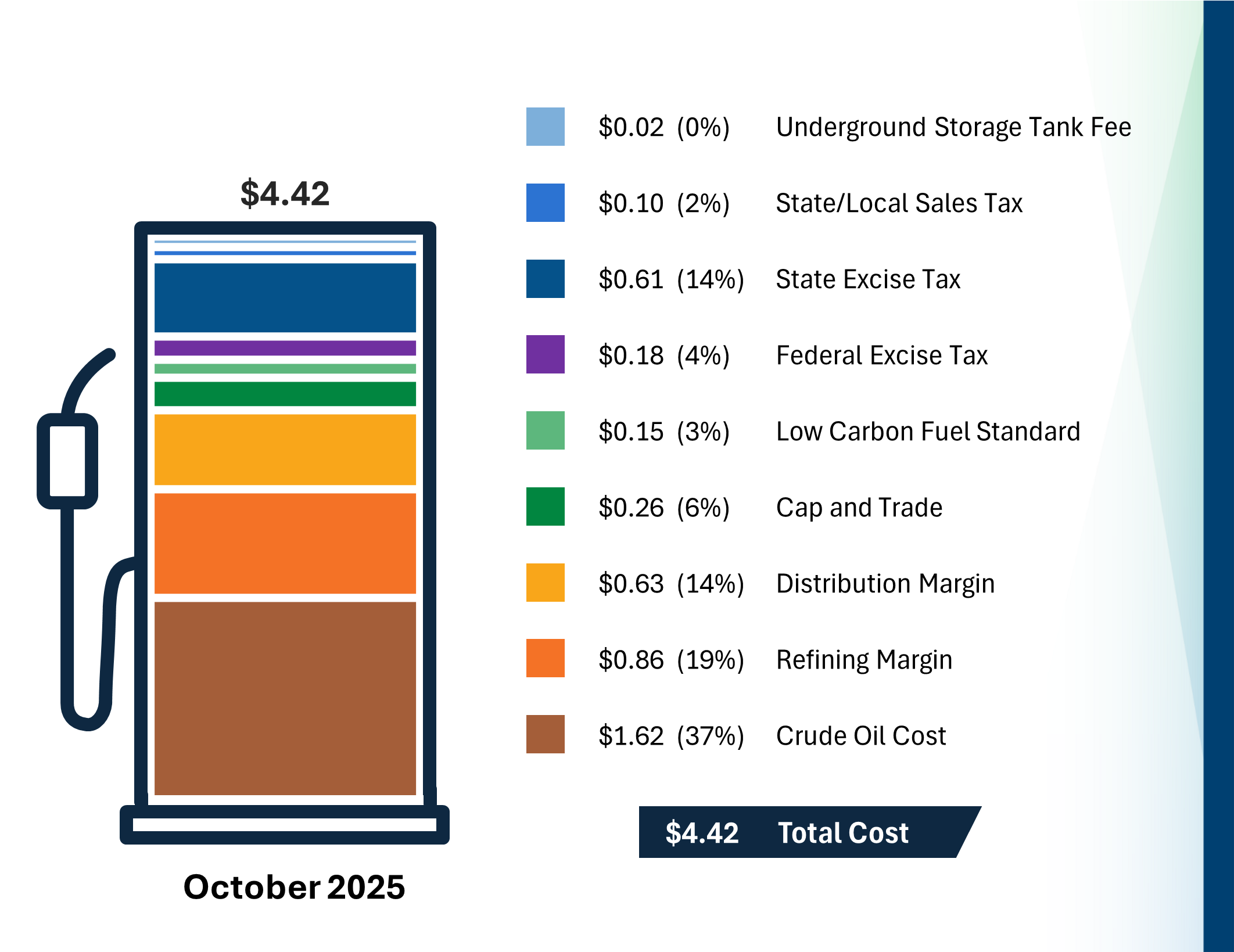This page details the estimated gross margins for both refiners and distributors as well as other components that make up the California retail gasoline price. The term "margin" includes both costs and profits. The margin data is based on the monthly statewide average retail and monthly wholesale price of gasoline. The margin provided here is an indicator for the California market as a whole and not for any particular refiner or retailer of gasoline.
This webpage is being updated to reflect new data analysis methods and to incorporate margin data reported to the California Energy Commission (CEC) per the requirements of the California Oil Refinery Cost Disclosure Act (Senate Bill (SB) 1322). For more information on refiner margins and SB 1322 data, please visit the California Oil Refinery Cost Disclosure Act webpage.
The information provided below is temporary while a new dashboard is being developed. In October 2025, the average retail gasoline price was $4.42 per gallon. To view the detailed breakdown of the price components, see the chart below or download the data.
Data Last Updated: December 15, 2025
Wholesale Gasoline Price: The wholesale gasoline price is a weighted average of the different sales wholesale channels reported by refiners on the CEC-M1322 report. The wholesale channels included are: Branded Rack, Unbranded Rack, Dealer Tank Wagon, and Internally Priced (Company Owned and Operated) Sales. Weighted average is based off the sales volumes reported by each refiner each month.
Distribution Costs, Marketing Costs, and Profits: The costs associated with the distribution from terminals to stations and retailing of gasoline, including but not limited to: franchise fees, and/or rents, wages, utilities, supplies, equipment maintenance, environmental fees, licenses, permitting fees, credit card fees, insurance, depreciation, advertising, and profit.
Crude Oil Cost: The volume-weighted average price of Foreign and Domestic Crude Oil Purchases as reported by refiners on the CEC-M1322 report.
Refinery Costs and Profits: The costs associated with refining and terminal operations, crude oil processing, oxygenate additives, product shipment and storage, oil spill fees, depreciation, purchases of gasoline to cover refinery shortages, brand advertising, and profits.
State Underground Storage Tank Fee (UST): The state underground storage tank fee is currently 2.0 cents per gallon.
State and Local Sales Tax: An average state sales tax rate of 2.25% percent is used in the calculation of the distribution margin although the actual sales tax rate does vary throughout California.
Low Carbon Fuel Standard (LCFS): Pass through cost associated with the California Air Resources Board (CARB) Low Carbon Fuel Standard program. Volume-weighted average taken across the same sales channels used in the Wholesale Gasoline Average Price.
Cap and Trade: Pass through cost associated with the CARB Cap and Trade Program. Volume-weighted average taken across the same sales channels used in the Wholesale Gasoline Average Price.
State Excise Tax: The California state excise tax is currently 61.2 cents per gallon.
Federal Excise Tax: The federal excise tax is currently 18.4 cents per gallon.
Retail Gasoline Price: The monthly average price for California from the Energy Information Administration (EIA)
Data Collection Information: Numbers are collected from the following sources to calculate the report.
- Retail Gasoline Price: U.S. Energy Information Administration (EIA) posted monthly retail gasoline prices for California Regular Reformulated Gasoline.
- Wholesale Gasoline Prices: CEC M1322 Report
- Crude Oil Costs: CEC M1322 Report
- California State Tax Rates for Fuels: Sales Tax Rates for Fuels (ca.gov)
- Federal Excise Tax: Frequently Asked Questions (FAQs) - U.S. Energy Information Administration (EIA)
Note: The Energy Commission cannot estimate profit margins based on average retail prices and observed wholesale market prices. This is because detailed, reliable data on refining and distribution costs, costs paid by approximately 10,000 retail locations, hundreds of wholesale marketers, jobbers, and distributors is not available.
Citing: Please cite use of these data and images. California Energy Commission [Year]. California Energy Commission Data last updated [insert date last updated]. Retrieved [insert date retrieved] from [Page URL]
Refiner Margin
Refiner Margin (costs and profits) is calculated by subtracting the market price for crude oil from the wholesale price of gasoline. The result is a gross refining margin which includes the cost of operating the refinery as well as the profits for the refining company. Spot Pipeline and Bulk Sales are not included in this calculation since these transactions are between industry participants and are not for retail sales. Refiner costs and profits may differ from the Gross Gasoline Refining Margins shown on the California Oil Refinery Cost Disclosure Act webpage.
The price of crude oil is based on the volume-weighted average of crude oil purchases reported by refiners. The market price of crude oil also includes its own share of costs and profits. In the case of a vertically integrated oil company, the same company that owns and operates the oil field also owns and operates the refinery. Several vertically integrated oil companies operate in California including BP, Chevron, ExxonMobil, and Shell.
For simplicity, the refining margins shown are based on producing one barrel of gasoline from one barrel of crude oil. No adjustments are made for other refined products.
Distribution Margin
Distribution margin (distribution costs, marketing costs, and profits) is calculated by subtracting the wholesale gasoline price, taxes, and fees (state sales tax, state excise tax, federal excise tax, environmental programs, and a state underground storage tank fee) from the monthly average retail sales price.
The distribution margin can be either positive or negative in value. A negative distribution margin implies that some gasoline is being sold at a loss. Similar to the refining margin, the distribution margin also includes the costs and profits of operating the retail gas station as well as various transportation and storage fees incurred once gasoline is moved from the bulk terminal to the retailer. Most branded franchisees purchase gasoline at a delivered price called the Dealer Tank Wagon price that is typically higher than the branded rack price. A retail-specific margin is not available at this time.

